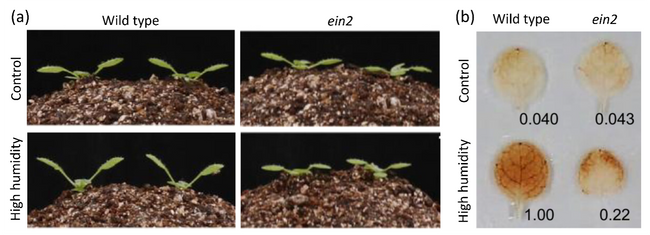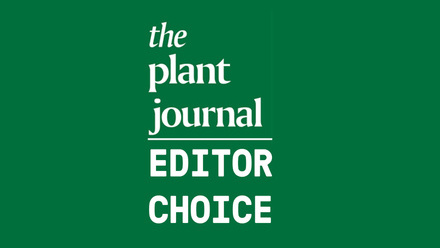January 2024 TPJ Editor choice:Left out in the rain: ethylene emerges as a novel regulator of responses to air humidity
Highlighted publication: Ethylene signaling modulates air humidity responses in plants.
https://doi.org/10.1111/tpj.16556
Left out in the rain: ethylene emerges as a novel regulator of responses to air humidity
Air humidity directly impacts a plant’s water status and thereby its entire physiology. Low air humidity can have detrimental effects for the plant’s health, increasing water loss and thereby impacting plant vigour and biomass production. But high air humidity comes with its own challenges: while it increases water use efficiency, decreased transpiration can result in reduced cooling and impaired nutrient uptake via the transpiration stream. In addition, high air humidity increases the risk of foliar diseases, presumably by creating a water-rich environment beneficial for pathogen growth, and some pathogens purposefully modify water availability in the apoplast. Plants acclimate to high air humidity by changing stomatal conductance and cuticle permeability; the signalling events that bring about these changes, however, remain largely unknown.
Jiang, Yao and colleagues set out to elucidate early humidity signalling processes: they reasoned that external air humidity might first be sensed at the plasma membrane and therefore monitored changes in the proteome and phosphoproteome of Arabidopsis membrane proteins when plants were shifted from medium (60% relative humidity, RH) to high (95% RH) air humidity. Substantial changes in protein accumulation and phosphorylation were observed within 30 minutes upon high humidity exposure. These fast responses were distinct from wider changes in the (phospho)proteome after 24 hours and provided the authors with a set of candidates for early humidity signalling components.
They then analysed Arabidopsis loss-of-function mutants to determine whether genes encoding any of these candidates are involved in humidity responses. Rather than going through the more elaborate process of quantifying physiological parameters such as stomatal conductance, the authors screened for changes in the upwards movement of petioles (hyponasty), a growth response they found to be strongly induced under high humidity in wild-type plants. Strikingly, a mutation in ETHYLENE INSENSITIVE 2 (EIN2), which encodes a core component of ethylene signalling located at the ER membrane, completely abolished the hyponastic response to high humidity (Fig. 1a). A similar phenotype was observed in the ein3 ein3-like 1 (eil1) double mutant, which lacks two master transcription factors of the ethylene signalling pathway.
Hyponastic growth was not the only humidity response altered in the ethylene signalling mutants: both mutants displayed decreased rosette size only when grown under high humidity, suggesting that they suffer from impaired fitness under these conditions. The growth phenotypes observed in ein2 and ein3 eil1 were accompanied by changes in humidity-regulated gene expression as well as a reduced accumulation of reactive oxygen species (Fig. 1b). Taken together, these observations strongly implicated ethylene in early humidity signalling. Jiang et al. further corroborated this hypothesis by observing that ethylene biosynthesis genes are rapidly induced and, consequently, ethylene levels quickly rise upon high humidity treatment.
Ethylene is a versatile gaseous plant hormone: it has a key role in controlling ripening processes and is also involved in responses to abiotic stresses such as flooding, drought, heat and high salinity. The findings by Jiang et al. suggest an important role for ethylene in the early response to high humidity stress. Ethylene thus represents an interesting contrast to the plant hormone abscisic acid (ABA), which is thought to control stomatal opening in response to changes in air humidity and whose levels drop under high humidity. Ethylene and ABA have opposing effects on stomatal closure during drought and one can speculate that they might act antagonistically in high humidity responses as well.

Figure 1
Responses to high air humidity are impaired in the ein2 ethylene signalling mutant.
- Hyponasty phenotype of wild type and ein2 plants under control conditions and high air humidity.
- Accumulation of reactive oxygen species detected by 3, 3'-diaminobenzidine staining in wild-type and ein2 plants under control conditions and high air humidity. Numbers indicate staining intensity quantified with ImageJ.
Figure modified from Jiang et al.




